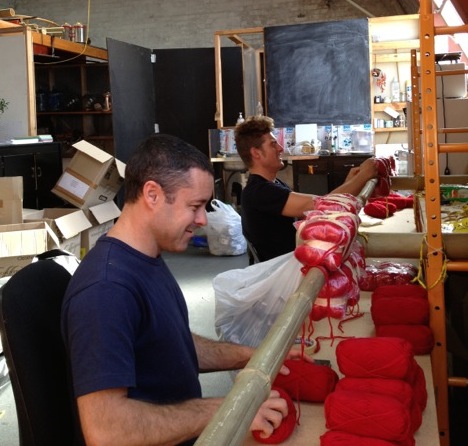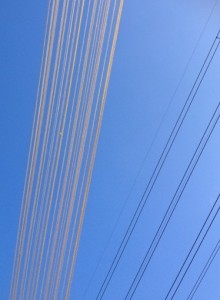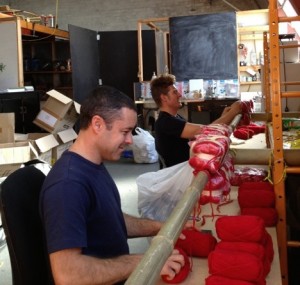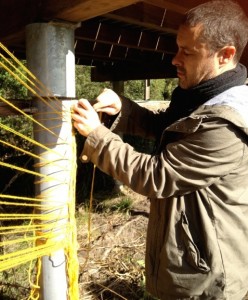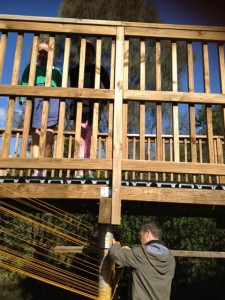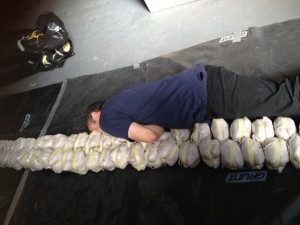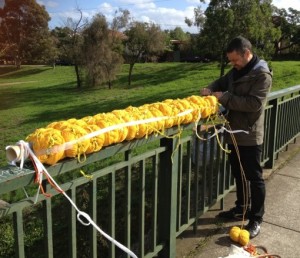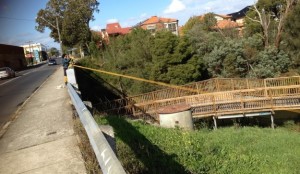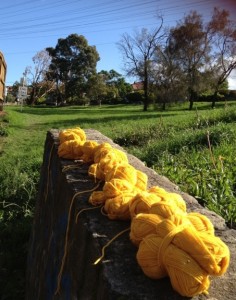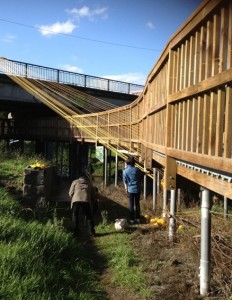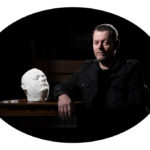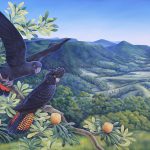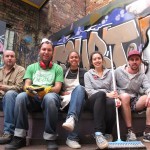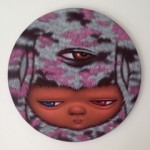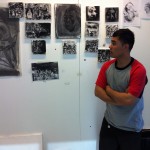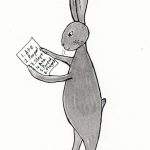By Celeste Hawkins
When a bunch of multi-skilled artists get together, each bringing with them their own unique talents and qualities you immediately have a force of creative energy, that if harnessed, can produce something very special. Then, on top of that, throw in a shared passion for sustainability and community involvement and you get the Slow Art Collective. Recently, I had to the chance to speak to Dylan Martorell and Chaco Kato, two thirds of the collective. These guys are playing with wool for an exciting installation for Wool Week at the moment, and lots of it!
Dylan Martorell:
How did the Slow Art Collective come about?
The Slow Art Collective was Chaco’s idea-she saw an exhibition of mine at Craft Victoria- where I had made hand made instruments using recycled materials. Initially, the Collective was also with Melbourne artist Ash Keating, but we have had a few other artists collaborate with us since then, including Tony Adams. Chaco had won a prize to have a solo exhibition at Monee Ponds gallery but had decided to form a collective with us and use that space for a show instead.
Have you worked with wool before?
Yes I have, I use found materials and used materials-but it’s really great to have access to this amount of wool and quality. We have ten boxes with four different colours; red, orange, yellow and white.
Can we have a sneaky preview of the work you’re doing?
The work will be suspended in the air from bamboo to a series of points on the ground and will house live sheep, models and furniture, to name a few. We will basically be creating an exhibition space for the other exhibits.
You work across many disciplines, how do you handle moving from one art form to the next?
Drawing, music and installation are quite different yet these mediums also feed into each other. Structures of drawings will suggest ways of making music and the shape of a drawing will also suggest a sculptural work. Drawing however, is mainly a solo occupation whereas the installation or music tends to be more collaborative in nature.
I mostly make a living out of creating drawings, but I couldn’t do that full time as I also enjoy the collaborative and improvisational work. Sometimes I’m able to get grants and other times the money made from drawings funds my music or other projects, such as trips to Asia. I want to do it. As for the music, it’s nice not to put reliance on making money from it. The joy comes from the music and capabilities of music to connect people and jump linguistic barriers.
How is your work received in Asia?
Very well. They have a very different concept of public space; their outdoor life is very different. Australians tend to be more internalized and behind closed doors!
I asked Dylan about his work, as there often seems to be tribal or religious qualities in his many designs- in the form of repeated patterns and colours.
I’ve never really thought about my influences or where they come from. I guess I am drawn to all those things-they’re innate!
What are the Collective’s plans for the future?
We will be working on another really interesting wool project next year in Castlemaine. We have the opportunity to work in an old carpet-making factory with a kinetic loom, turning the space into an active instrument, which I’m very excited about.
Chaco Kato:
Like Dylan, you are a multidisciplinary artist. How does your illustration practice inform your sculptural practice? Is there a link between the two?
I make sculpture and also a drawing as if I am creating music. In other words, the elements of line, color and pattern are both ‘drawing’ and ‘music’.
I love both of these practices very much. Just the scale and nature of the context is very different. I do love abstract drawing, and I also do children’s book illustration. An abstract drawing is like a child’s scribble (many people say), but it to me it is a conversation with myself. Kids book illustration is more like a dialogue with a story. And sculpture or installation is like a communication with materials and also the space or site in which it is situated.
One is physically large. So in a sense when making an installation, I will be ‘inside’ it. People who view the work will also have the experience of being ‘in’ it. The work will be completed when people are physically occupying the space in there.
A drawing may be (physically) small but my whole body will become one with the process of making it. My breath, gaze and body movement will be synchronized when I am really into it, which is the only way I can produce a really good drawing.
The focus of the SAC is the promotion of sustainability, ethics and a sense of community through your art making practices. What is the community’s perception of your work? How do you obtain feedback?
I think people enjoy seeing our work, as it doesn’t look like ‘art’. It doesn’t look like a kind of art people would see in NGV – like a master painting in a big frame or bronze sculpture. It can be looked as children’s fun creation by using something from the rubbish bin!
Many people responded enthusiastically to our recent work ‘Marlerkey’ for the Melbourne Now exhibition at the NGV.
Some comments were:
‘I found the best way to use my recycled materials’… ‘ I’ve never seen such a great fun project using just junk!’…‘My children didn’t want to move from the installation ‘… ‘My kids started making things instead of a smart phone game after that!’
Indeed, when we do a workshop, a few parents always come and tell us that it’s so good to see their kid is ‘DOING’ something away from their smartphone!
What drives you to do community based and installation artwork?
I believe that humans have a gene that switches on a passion for making things regardless our circumstance. That is a drive for living! In a way, I would like to make something to collaborate with that ‘passion’, rather than making a masterpiece by myself in a studio.
I am interested in creating something with very humble materials to collaborate within the existing environment. What I mean by that is, instead of making my work in an isolated studio and bringing the work to the gallery space, I would prefer to go somewhere, outside or inside, to engage with the venue or site. It can be in the bush with trees, or it can be in the city among buildings. I like to be responsive to the environment rather than control the space.
My string work is based on that idea. I like to be responsive to the space, as if a spider uses any environment as its home or ‘nest’. For the wool week work, it is great to be able to incorporate the idea of where wool is from and what we can do with it. Creating a big shelter for live sheep is a very exciting concept.
I like to make something I really enjoy, and also inspire people to be creative. In a way, it’s like giving a passport to someone who can in turn make anything with any materials you have. I like to facilitate a workshop in a public space and invite others to create something together and I will ‘edit’ the work to make it as an artwork. By this process, it starts to to blur the boundary between who is an artist and who is the viewer.
Wool Week (11 – 17 May), an initiative for The Woolmark Company and The Campaign for Wool, which aims to educate as many people as possible about the incredible natural benefits, versatility and renewable nature of wool.
From farm to fashion, furnishings and art – the use of wool will be highlighted at Melbourne’s Federation Square on Thursday 15th and Friday 16th May.
